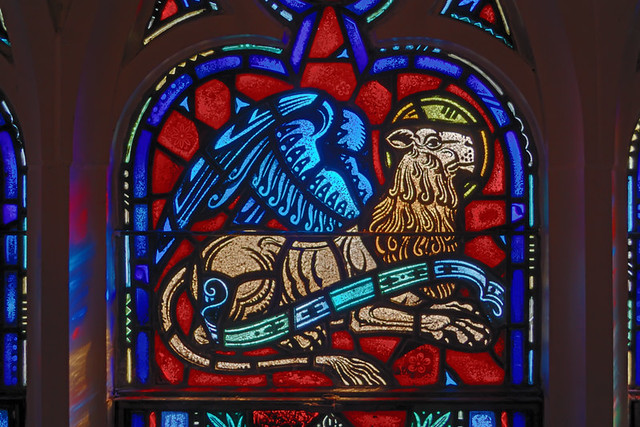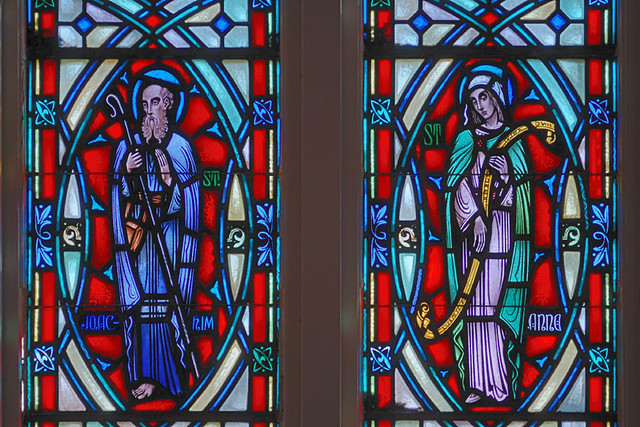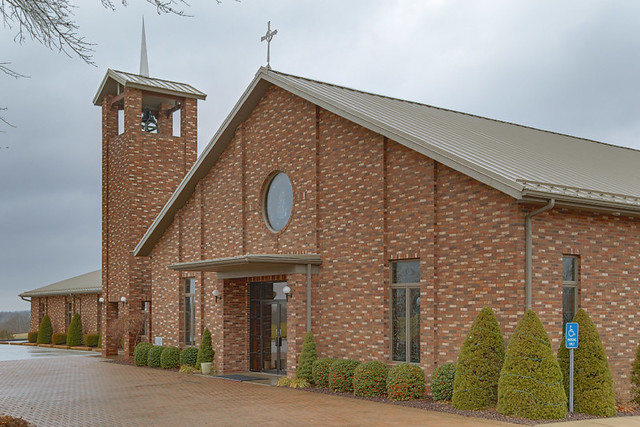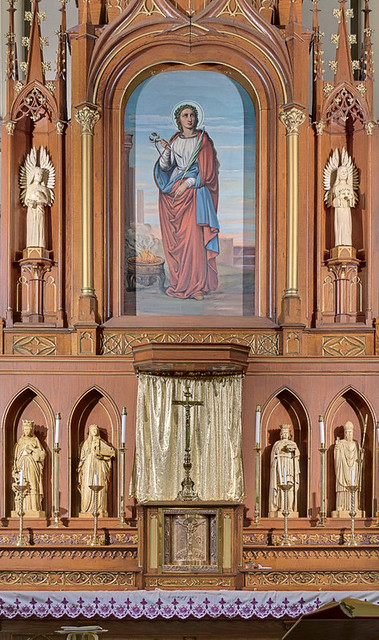 SAINT FRANCIS DE SALES ORATORY EMAIL NEWSLETTER 2653 Ohio Avenue Saint Louis, Missouri 63118 www.institute-christ-king.org www.TraditionForTomorrow.com 314-771-3100 | ||
|
Friday, February 25, 2011
News From the Oratory
Controversy Over Consequences
UNDOUBTABLY MOST of my readers are familiar with the current controversy raging in Catholic circles in the United States:
Did Live Action lie?
Is Deception Always Wrong? I'm Not Convinced
Building a Culture of Lie
Why Live Action did right and why we all should know that
Faustian Bargains
Augustine vs. the Priscillianists
In Defense of Live Action
Live Action president responds to controversy over group's tactics
Moral Theology? Bah! Humbug!
Justified Deception or Lying? The Case of Live Action v. Planned Parenthood
Is Lying Ever Right?
Catechism of the Catholic Church ¶2464
The controversy is so bad that old friends have become enemies and people are losing their faith over this. Satan laughs.
The argument is revolving around two basic thoughts:
Many are arguing purely from the objective moral law. Lying is a sin, and the Saints, the Magisterium, moral theologians, sacred Tradition, and sacred Scripture all strongly agree. But neglecting the subjective and relative circumstances is legalism and is unjust. Jesus criticized the Pharisees for legalism. But Martin Luther coined the term ‘antinomian’ to describe those Protestant sects whom he accused of rejecting legalism to the point of recognizing no law at all. True virtue is found between legalism and antinomianism.
Others may only consider subjective factors, which is pure hedonism — if it feels good, do it. This can hardly be the foundation for a good society, for only the strong will thrive. More nuanced views will claim that someone ought to put off easy pleasures to gain greater pleasures, but then this brings up the problem of distinguishing greater and lesser desires: could this hierarchy of desire be somehow rooted in human nature, or something higher?
Relativism only takes circumstances into account. This is very fashionable because it appears to be tolerant, but again it isn't a basis for a good society because it fails to answer why some actions are better than another. Why not choose any action? If relativism is the only means of judging moral culpability, then why should society judge any action wrong? Were you there? How can you judge? But we know from history that moral relativists judge others extremely harshly, more than those who have the orthodox view of moral culpability.
Modern thinking rejects the objective component of moral culpability (usually for reasons of sexuality or greed), and tries to devise ethical systems based solely on subjective and relative factors. Situational Ethics, devised in the 1960s by the Episcopalian priest Joseph Fletcher (R.I.P.), ignored all moral law except supposedly agape love. Fletcher's system justified abortion, euthanasia, sterilization, eugenics, genetic engineering, and infanticide. Fletcher later became an atheist.
Proponents of these antinomian moral systems like to construct difficult moral dilemmas, where you have to decide on a course of action. Here is one of Fletcher's examples:
Another problem with antinomians is that they apply this morality only to themselves; everyone else will be forced to follow their laws without choice or conscientious objection — which is pure legalism. Please remember that evils are found in opposite pairs.
Here is another moral dilemma:
The intention of situational ethics is to make you to chose evil.
Likewise in the Live Action controversy (seen in the links above) people have constructed moral dilemmas regarding lying, and why it might be justified in some situations. For example:
But it isn't World War II. There is no Gestapo. Although the Jews will remain a target of destruction by Satan and his minions until the end of the age, this scenario will never happen in precisely this way. We can discuss moral culpability from the comfort of our homes or offices, but can we predict with certainty what we would do under extreme circumstances? Who has the right to determine morality from an artificial situation like this? If you believe that the ends justify the means, why is it that some ends are preferable over some means? Doesn't this require an objective factor in moral culpability? Aren't the means ends in themselves?
The answer to this controversy is to understand what the objective moral law is about. Lying is a sin, one of many sins. It is a person's responsibility to avoid sin every day, even in ordinary situations. Do you habitually lie to your family, friends, superiors, subordinates, or to the strangers you meet every day? Or do you make truthfulness a part of yourself? Do you lie when you can get away with it, and are truthful if you will be found out? Do you lie in trivial situations, while you pretend that you will be truthful in important situations? Are you plainspoken, or are you always trying to find nuanced ways to tell untruth so that you don't feel guilt about it? Or do you hold to a philosophy that there is no truth so that you can lie with impunity?
Constant daily practice of upholding the truth makes you a more truthful person. Daily practice of the virtues will make you a more virtuous person. Forget about hypothetical situations. Be truthful and moral NOW (yes, I am preaching to myself here). If a modern-day Gestapo comes knocking on your door, then, and only then will you know what to do, with God's grace.
Did Live Action lie?
Is Deception Always Wrong? I'm Not Convinced
Building a Culture of Lie
Why Live Action did right and why we all should know that
Faustian Bargains
Augustine vs. the Priscillianists
In Defense of Live Action
Live Action president responds to controversy over group's tactics
Moral Theology? Bah! Humbug!
Justified Deception or Lying? The Case of Live Action v. Planned Parenthood
Is Lying Ever Right?
Catechism of the Catholic Church ¶2464
The controversy is so bad that old friends have become enemies and people are losing their faith over this. Satan laughs.
The argument is revolving around two basic thoughts:
- Lying is sinful.
- We have to do something about abortion. What Live Action did worked.
- Objective moral law.
- Subjective mental state.
- Relative circumstance.
Many are arguing purely from the objective moral law. Lying is a sin, and the Saints, the Magisterium, moral theologians, sacred Tradition, and sacred Scripture all strongly agree. But neglecting the subjective and relative circumstances is legalism and is unjust. Jesus criticized the Pharisees for legalism. But Martin Luther coined the term ‘antinomian’ to describe those Protestant sects whom he accused of rejecting legalism to the point of recognizing no law at all. True virtue is found between legalism and antinomianism.
Others may only consider subjective factors, which is pure hedonism — if it feels good, do it. This can hardly be the foundation for a good society, for only the strong will thrive. More nuanced views will claim that someone ought to put off easy pleasures to gain greater pleasures, but then this brings up the problem of distinguishing greater and lesser desires: could this hierarchy of desire be somehow rooted in human nature, or something higher?
Relativism only takes circumstances into account. This is very fashionable because it appears to be tolerant, but again it isn't a basis for a good society because it fails to answer why some actions are better than another. Why not choose any action? If relativism is the only means of judging moral culpability, then why should society judge any action wrong? Were you there? How can you judge? But we know from history that moral relativists judge others extremely harshly, more than those who have the orthodox view of moral culpability.
Modern thinking rejects the objective component of moral culpability (usually for reasons of sexuality or greed), and tries to devise ethical systems based solely on subjective and relative factors. Situational Ethics, devised in the 1960s by the Episcopalian priest Joseph Fletcher (R.I.P.), ignored all moral law except supposedly agape love. Fletcher's system justified abortion, euthanasia, sterilization, eugenics, genetic engineering, and infanticide. Fletcher later became an atheist.
Proponents of these antinomian moral systems like to construct difficult moral dilemmas, where you have to decide on a course of action. Here is one of Fletcher's examples:
I dropped in on a patient at the hospital who explained that he only had a set time to live. The doctors could give him some pills (that would cost $40 every three days) that would keep him alive for the next three years, but if he didn't take the pills, he’d be dead within six months. Now he was insured for $100,000, double indemnity and that was all the insurance he had. But if he took the pills and lived past next October when the insurance was up for renewal, they were bound to refuse the renewal, and his insurance would be canceled. So he told me that he was thinking that if he didn't take the pills, then his family would get left with some security, and asked my advice on the situation.We ought to be aware that the situation proposed is designed to force you to chose euthanasia. It is a simple extension from this conclusion to euthanasia as public policy. In fact, our options are not limited, nor can we predict the future with great accuracy, and situationism ignores or trivializes grace.
Another problem with antinomians is that they apply this morality only to themselves; everyone else will be forced to follow their laws without choice or conscientious objection — which is pure legalism. Please remember that evils are found in opposite pairs.
Here is another moral dilemma:
Former President George W. Bush and President Barack Obama have been kidnapped and are tied to the tracks in a railroad switching yard. A train is heading towards them. You can throw a switch one of two ways, so that only one of either President Bush or President Obama is run over, while saving the other; if you do nothing, both of them will be run over by the train. What do you do?Undoubtably many people would love to throw the switch one way or the other — or chose to do nothing. But my advice is to not play the game at all — for this game is designed purely to reveal your partisan bias. If you do reveal a choice, please be very aware of what you are publicly advocating.
The intention of situational ethics is to make you to chose evil.
Likewise in the Live Action controversy (seen in the links above) people have constructed moral dilemmas regarding lying, and why it might be justified in some situations. For example:
It is World War II and you are hiding Jews in your attic. The Gestapo knocks on your door and asks you if any Jews are in your home. If the Gestapo finds them, they will be certainly murdered. But lying is a sin, so you cannot lie to the Gestapo; moral theology says you cannot sin to prevent sin. So in defense of the truth, do you honestly reply to the Gestapo, even though your Jews will be murdered?This is a classic situational ethics dilemma, and from this dilemma come charges of Pharisaism, legalism, and even disbelief — some refuse to believe in a God that would prefer a person not to lie than to save innocent lives. Controversialists are jumping through hoops attempting to nuance what is a lie and what is not, while others are saying that it doesn't matter at all — the ends justify the means.
But it isn't World War II. There is no Gestapo. Although the Jews will remain a target of destruction by Satan and his minions until the end of the age, this scenario will never happen in precisely this way. We can discuss moral culpability from the comfort of our homes or offices, but can we predict with certainty what we would do under extreme circumstances? Who has the right to determine morality from an artificial situation like this? If you believe that the ends justify the means, why is it that some ends are preferable over some means? Doesn't this require an objective factor in moral culpability? Aren't the means ends in themselves?
The answer to this controversy is to understand what the objective moral law is about. Lying is a sin, one of many sins. It is a person's responsibility to avoid sin every day, even in ordinary situations. Do you habitually lie to your family, friends, superiors, subordinates, or to the strangers you meet every day? Or do you make truthfulness a part of yourself? Do you lie when you can get away with it, and are truthful if you will be found out? Do you lie in trivial situations, while you pretend that you will be truthful in important situations? Are you plainspoken, or are you always trying to find nuanced ways to tell untruth so that you don't feel guilt about it? Or do you hold to a philosophy that there is no truth so that you can lie with impunity?
Constant daily practice of upholding the truth makes you a more truthful person. Daily practice of the virtues will make you a more virtuous person. Forget about hypothetical situations. Be truthful and moral NOW (yes, I am preaching to myself here). If a modern-day Gestapo comes knocking on your door, then, and only then will you know what to do, with God's grace.
Wednesday, February 23, 2011
"Where Have All the Good (Wo)Men Gone?"
SEE THE ARTICLE Where Have All the Good (Wo)Men Gone? by Jennifer Fulwiler, which quotes the article Where Have The Good Men Gone? by Kay S. Hymowitz.
Social Justice is not just a catchphrase for those who want to pursue liberal issues. It in fact derives from Catholic teaching greatly developed in the 19th and is de fide. The situation described in the articles above is very much a social justice issue. Unfortunately, the division between the sexes is presented as class conflict of the marxist kind: instead of partners, men and women are seen as competitors.
Social Justice is not just a catchphrase for those who want to pursue liberal issues. It in fact derives from Catholic teaching greatly developed in the 19th and is de fide. The situation described in the articles above is very much a social justice issue. Unfortunately, the division between the sexes is presented as class conflict of the marxist kind: instead of partners, men and women are seen as competitors.
Tuesday, February 22, 2011
Upon This Rock I Will Build My Church
ACCORDING TO ancient tradition, on February 22nd Our Lord granted Saint Peter leadership of His Church on earth, symbolically represented with keys in this stained glass window:

At Saint Joseph Church, in Louisiana, Missouri.

At Saint Joseph Church, in Louisiana, Missouri.
Monday, February 21, 2011
Some Photos of Saint Mary's Church, in Alton, Illinois
LAST FRIDAY, I made a brief visit to Saint Mary's (Immaculate Conception) Church, in Alton, Illinois. This church was renovated since my last visit four years ago, and on this day, workmen were busy refinishing the wooden doors.


Mary's altar.

Rose window in the choir loft. The window depicts a psaltry, Saint Cecilia, King David the psalmist, angels, and symbols of the Evangelists.

A winged-lion, symbol of Saint Mark the Evangelist.

Saints Joachim and Anne.

Saint John Chrysostom.


Mary's altar.

Rose window in the choir loft. The window depicts a psaltry, Saint Cecilia, King David the psalmist, angels, and symbols of the Evangelists.

A winged-lion, symbol of Saint Mark the Evangelist.

Saints Joachim and Anne.

Saint John Chrysostom.
Photo of Mary Queen of Peace Mission, in Clarksville, Missouri

Mary Queen of Peace Mission, located in the Mississippi River town of Clarksville, Missouri. The mission was founded in 1951 and is part of the Diocese of Jefferson City.
The church is in Pike County, about 74 highway miles northwest of downtown Saint Louis.
Friday, February 18, 2011
Père Marquette Monument

Père Marquette Monument, near Grafton, Illinois. Inscribed at the base:
At this place in early August 1673
Marquette, Joliet and five
companions entered Illinois
dawn-heralds of Religion, Civil
Government and Consecrated Labor.
Dedicated September 1, 1929
RT. REV. JAMES A. GRIFFIN D.D.
BISHOP OF SPRINGFIELD, ILLINOIS
Thursday, February 17, 2011
Scatter Us Out
IN THE 1960s the hymnody of Holy Mother Church was made relevant to youth by adopting the folk-music style of that generation. That music is still with us today:
This is illustrated by a unique depiction of the Sacred Heart.
This is illustrated by a unique depiction of the Sacred Heart.
Monday, February 14, 2011
Saint Valentine, Priest and Martyr

Effigy and relics of Saint Valentine; at Old Saint Ferdinand Shrine, in Florissant, Missouri. The shrine was the home of Saint Rose Philippine Duchesne.
Valentine was martyred in A.D. 270, in Rome on the Flammian way.
Red is the symbolic color of both love and of the martyrs, for it is the color of blood; and there is no greater love than to give one's own life for the sake of a beloved.
Friday, February 11, 2011
News from the Oratory
|
Also, this weekend the Oratory is hosting a play put on by the high school co-op. Details here.
In Case You've Heard...
NO, Catholics cannot go to confession via an Apple iPhone.
No, the Catholic Church is not selling an iPhone app to be used for confession.
No, this app does not replace confession.
No, you cannot confess long distance.
No, you cannot confess using your computer.
No, the Vatican does not endorse this app.
No, the Vatican does not condemn this app.
Yes, the app has the imprimatur of one U.S. Bishop acting under his personal authority.
Yes, this app does guide you through an examination of conscience.
Yes, the app is flawed but the developer is updating it.
Fr. Z reports on this here, here, here, and here. Jeff Geerling comments on it here. You can get the app here for $1.99.
[To those who may not know, ‘app’ is short for application, or a computer program, particularly one that is designed to work on advanced cell phones or hand-held computers.]
Actually, you can confess your sins to anyone: your spouse, a stranger on a bus, your bartender, or even directly to God (although He already knows all of your sins, past, present, and future). You can only get absolution through a priest however, after confessing to him.
It is funny how the world hates the idea of Confession — implying all sorts of sinister motives to it, while simultaneously endorsing psychological analysis. Unlike the priest in the confessional, the psychologist knows who you are, where you live, and requires names, places, and details that must never be revealed in the box. And a psychologist almost always charges you for the service, while a priest must never charge you. Nowadays, a lot of people are being forced to go to psychoanalysis. On the contrary, you can go to confession and confess whatever you want, or if you aren't a sinner, then you don't have to go at all; you can do the penance (often just saying one Our Father) or you don't; no one is forcing you to do anything. [Yes, I'm cynical here]. Sigmund Freud, the founder of psychoanalysis, noted that Catholics who frequented the sacrament of confession had no need to see him.
Guaranteed absolute secrecy used to be a distinctive feature of the sacrament of confession, but this was called into question several decades ago, and many now consider it unimportant. [A correspondent tells me that during a recent first confession at her church, the girls invariable confessed face-to-face, while the boys invariably confessed behind the screen. I'm not quite sure what to make of this.] I think practical secrecy is utterly important, and certain old customs, such as never confessing to a superior, confessing behind a screen, confessing at a church that has long confessional lines, and taking advantage of confession during a pilgrimage or during a parish mission is prudential, although obviously not essential.
The secrecy inherent in the traditional confessional is good for penitents — it does lessen anxiety — it is also good for priests and may lessen the risk of false accusations.
Here in Saint Louis, the sacrament is available widely.
No, the Catholic Church is not selling an iPhone app to be used for confession.
No, this app does not replace confession.
No, you cannot confess long distance.
No, you cannot confess using your computer.
No, the Vatican does not endorse this app.
No, the Vatican does not condemn this app.
Yes, the app has the imprimatur of one U.S. Bishop acting under his personal authority.
Yes, this app does guide you through an examination of conscience.
Yes, the app is flawed but the developer is updating it.
Fr. Z reports on this here, here, here, and here. Jeff Geerling comments on it here. You can get the app here for $1.99.
[To those who may not know, ‘app’ is short for application, or a computer program, particularly one that is designed to work on advanced cell phones or hand-held computers.]
Actually, you can confess your sins to anyone: your spouse, a stranger on a bus, your bartender, or even directly to God (although He already knows all of your sins, past, present, and future). You can only get absolution through a priest however, after confessing to him.
It is funny how the world hates the idea of Confession — implying all sorts of sinister motives to it, while simultaneously endorsing psychological analysis. Unlike the priest in the confessional, the psychologist knows who you are, where you live, and requires names, places, and details that must never be revealed in the box. And a psychologist almost always charges you for the service, while a priest must never charge you. Nowadays, a lot of people are being forced to go to psychoanalysis. On the contrary, you can go to confession and confess whatever you want, or if you aren't a sinner, then you don't have to go at all; you can do the penance (often just saying one Our Father) or you don't; no one is forcing you to do anything. [Yes, I'm cynical here]. Sigmund Freud, the founder of psychoanalysis, noted that Catholics who frequented the sacrament of confession had no need to see him.
Guaranteed absolute secrecy used to be a distinctive feature of the sacrament of confession, but this was called into question several decades ago, and many now consider it unimportant. [A correspondent tells me that during a recent first confession at her church, the girls invariable confessed face-to-face, while the boys invariably confessed behind the screen. I'm not quite sure what to make of this.] I think practical secrecy is utterly important, and certain old customs, such as never confessing to a superior, confessing behind a screen, confessing at a church that has long confessional lines, and taking advantage of confession during a pilgrimage or during a parish mission is prudential, although obviously not essential.
The secrecy inherent in the traditional confessional is good for penitents — it does lessen anxiety — it is also good for priests and may lessen the risk of false accusations.
Here in Saint Louis, the sacrament is available widely.
Hello? Hello?
I AM EASILY amused. I often get phone calls from a friend — and all I hear is shrieking children, obviously having a good time, with a parent in the background demanding “Give that back to me. That is not a toy.” Now if I attempt to talk back — “Hello hello, can you hear me? Helloooooooooooo?” the kids laugh even louder. I'm surprised when I do get a legitimate call from them. “Oh, it is you.”
My old reliable phone finally broke after many years of good service, and I got a new one, a free upgrade. Now many manufacturers attempt to copy the market leader (in this case, the Apple iPhone), but being short of funding, talent, intelligence, or common sense, this is often a failure. Some features are really hard to get right, and so a competent simplicity is no vice. Incompetent complexity is a vice. The touch screen display, for example, works, sort of, when I want it to (its actions are rather coarse and imprecise), but it also works far too well when I don't.
I take my phone with me wherever I go, and keep it in my pocket where it belongs. I got my first hint that something was wrong when my father called me several times — saying he was returning my call. I didn't call! At least I didn't remember calling — or did I? My memory must be failing on me.
Then I got a call from an acquaintance, who left a very lengthy message on the only possible reason why I would have called, and why I failed to leave a message. Kind of embarrassing, actually. But then I knew that there was a problem with the new phone. I managed to find the outgoing calls log, which showed me some of the recent self-dialing incidents. The phone dials itself when it moves around in my pocket, like when I'm walking. My sincere apologies to anyone I may have called by accident (especially at 3 a.m.)
This problem continued for several days. One day, the telephone dialed up four different people, some of whom I haven't talked to in years (I really do need to prune my phone's address book). I mentioned this problem to a friend, who suggested that it probably has lock screen feature. It does! I programmed the phone to not dial until I type in a short code. Problem solved.
However, what good is a cell phone if you can't use it in an emergency? That is the main reason why I have one — I've got the basic voice plan with no data services. Thinking of this eventuality, the phone maker thoughtfully allows anyone to dial the emergency number — 911 in the USA — even if the phone is locked. So instead of randomly dialing friends or family members, the phone randomly calls the government emergency response number! That is so not good. As the 911 operators can determine my location precisely through the cell phone, I imagined firemen smashing through my front door, or the highway patrol chasing my car. I quickly turned off that feature.
I sort-of solved the problem by leaving a fairly innocuous menu item on the screen before I turn it off and put it in my pocket. I have a feeling that I won't be keeping this phone for very long.
My old reliable phone finally broke after many years of good service, and I got a new one, a free upgrade. Now many manufacturers attempt to copy the market leader (in this case, the Apple iPhone), but being short of funding, talent, intelligence, or common sense, this is often a failure. Some features are really hard to get right, and so a competent simplicity is no vice. Incompetent complexity is a vice. The touch screen display, for example, works, sort of, when I want it to (its actions are rather coarse and imprecise), but it also works far too well when I don't.
I take my phone with me wherever I go, and keep it in my pocket where it belongs. I got my first hint that something was wrong when my father called me several times — saying he was returning my call. I didn't call! At least I didn't remember calling — or did I? My memory must be failing on me.
Then I got a call from an acquaintance, who left a very lengthy message on the only possible reason why I would have called, and why I failed to leave a message. Kind of embarrassing, actually. But then I knew that there was a problem with the new phone. I managed to find the outgoing calls log, which showed me some of the recent self-dialing incidents. The phone dials itself when it moves around in my pocket, like when I'm walking. My sincere apologies to anyone I may have called by accident (especially at 3 a.m.)
This problem continued for several days. One day, the telephone dialed up four different people, some of whom I haven't talked to in years (I really do need to prune my phone's address book). I mentioned this problem to a friend, who suggested that it probably has lock screen feature. It does! I programmed the phone to not dial until I type in a short code. Problem solved.
However, what good is a cell phone if you can't use it in an emergency? That is the main reason why I have one — I've got the basic voice plan with no data services. Thinking of this eventuality, the phone maker thoughtfully allows anyone to dial the emergency number — 911 in the USA — even if the phone is locked. So instead of randomly dialing friends or family members, the phone randomly calls the government emergency response number! That is so not good. As the 911 operators can determine my location precisely through the cell phone, I imagined firemen smashing through my front door, or the highway patrol chasing my car. I quickly turned off that feature.
I sort-of solved the problem by leaving a fairly innocuous menu item on the screen before I turn it off and put it in my pocket. I have a feeling that I won't be keeping this phone for very long.
Thursday, February 10, 2011
Photo of Our Lady of Victory Church, in Sereno, Missouri

The parish dates from 1908, and this church dates from 1997. This parish consolidates the now-closed Nativity of the Blessed Virgin Mary parish in Belgique, Our Lady of the Rosary parish in Claryville, and Saint John the Evangelist mission in Lithium. Like many other churches in that part of the Archdiocese, it is staffed by a priest of the Congregation of the Mission.
Sereno is an unincorporated hamlet located in rural Bois Brule township, Perry County, Missouri, and is about 84 highway miles southeast of downtown Saint Louis. Photo taken on December 31st, 2010.
Sunday, February 06, 2011
Lost Catholic Saint Louis
AN ALTAR, in the convent of the former Holy Innocents Catholic Church, in Saint Louis:

The church closed in 2005 and the convent is now an art studio; the chapel is a gallery. There was an exhibition going on at the time, and the chapel was crowded, and so I was only able to get a close up of the altar itself. Do you notice the markings on the stone before the altar?

That appears to be precisely where a priest would genuflect after consecration; the left marking would be from his shoe, and the larger marking on the right would be from his knee. Traces of piety remain.

Consecration took place on this spot; we see one of the five crosses on the altar mensa, and the capsule where the altar relics were kept.

The church closed in 2005 and the convent is now an art studio; the chapel is a gallery. There was an exhibition going on at the time, and the chapel was crowded, and so I was only able to get a close up of the altar itself. Do you notice the markings on the stone before the altar?

That appears to be precisely where a priest would genuflect after consecration; the left marking would be from his shoe, and the larger marking on the right would be from his knee. Traces of piety remain.

Consecration took place on this spot; we see one of the five crosses on the altar mensa, and the capsule where the altar relics were kept.
Saturday, February 05, 2011
Feast of Saint Agatha

Painting of Saint Agatha, virgin and martyr, at Saint Agatha's Church, in Saint Louis, Missouri. Photo taken March 5, 2010.
From the Monastic Diurnal, for Vespers:
Blessed Agatha standing in prison with outstretched hands prayed unto the Lord: O Lord Jesus Christ, good Master, I give Thee thanks Who hast enabled me to overcome the tortures of the executioners; bid me, O Lord, come happily to Thine unfading glory.
Thursday, February 03, 2011
Wednesday, February 02, 2011
Tuesday, February 01, 2011
History of National Party Conventions Held in Saint Louis
SAINT LOUIS WILL NOT host the 2012 Democratic National Convention; instead it will be held in Charlotte, North Carolina. It will be the first time that Charlotte will host such a national party convention. Click here for the news story.
In the early days of the Republic, candidates for the office of President were chosen by congressional party caucuses. As the nation expanded westward — seven western states entered the Union in the first third of the 19th century — remote geography led to severe differences of opinions between the voters and the politicians who resided in Washington D.C. The solution was to bring together larger numbers of party members in one place in a national party convention. The major parties held national presidential nominating conventions in nearly every election cycle since 1832. The most popular city for these conventions is Chicago, Illinois.
Saint Louis was the host of a number of national presidential nominating conventions:
National party conventions are now little more than celebrations.
In the early days of the Republic, candidates for the office of President were chosen by congressional party caucuses. As the nation expanded westward — seven western states entered the Union in the first third of the 19th century — remote geography led to severe differences of opinions between the voters and the politicians who resided in Washington D.C. The solution was to bring together larger numbers of party members in one place in a national party convention. The major parties held national presidential nominating conventions in nearly every election cycle since 1832. The most popular city for these conventions is Chicago, Illinois.
Saint Louis was the host of a number of national presidential nominating conventions:
- 1876, Democrats, nominating Samuel J. Tilden. First national party convention held west of the Mississippi. Platform positions included: complete acceptance of the permanent Union of the United States and the Constitution; separation of Church and State, particularly in public schools; opposition to sumptuary laws, carpetbagging, centralization, patronage, and debased currency; lower taxes and tariffs, land for settlers; and opposition to Asian and encouragement of European immigration. Held at the old Merchants Exchange Building (destroyed in 1958 and now the location of the Adam's Mark Hotel). Festivities included fireworks launched from the Old Courthouse.
- 1888, Democrats, nominating Grover Cleveland. The incumbent Cleveland was nominated unanimously. Platform positions included lower taxes, giving land to homesteaders, better veteran benefits, and opposition to cheap foreign labor and manufactured goods. Held at the St. Louis Exposition and Music Hall. This was one of the earliest buildings in the country to have electric lighting, and was the home of the symphonic orchestra. Located near Olive and 13th Streets, it is now the site of the Central Branch of the Saint Louis Public Library.
- 1896, Republicans, nominating William McKinley. The party platform supported the gold standard, a canal across Central America, the Cuban revolution, annexation of Hawaii, and women's rights. Originally to be held at the St. Louis Exposition and Music Hall, that venue needed work which could not be completed in time. Taking place soon after the Great Cyclone of '96, a temporary structure was built on the lawn south of City Hall.
- 1896, People's Party, nominating the Democrat's candidate, William Jennings Bryan. This short-lived but influential populist party supported poor famers in the South and Great Plains, and was opposed to bankers, large landowners, and the railroads. The party was simultaneously one of liberal progressivism and traditionalist conservatism, and got support from northern Democrats and southern Republicans. This convention was contentious and marked the waning of the party, which was crushed within a few years by violent disenfranchisement throughout the South. The convention was held in the same hall used by the Republicans a month earlier.
- 1904, Democrats, nominating Alton B. Parker. Held at the Coliseum of the St. Louis Exposition and Music Hall; the convention took place during the 1904 Olympics and World's Fair held in Saint Louis. This convention was called "one of the most exciting and sensational in the history of the Democratic Party." The platform called for lower taxes and tariffs, less government corruption, an end to monopolies and imperialism. It was in favor of the 8 hour work day, Panama Canal, direct election of Senators, and was against polygamy.
- 1916, Democrats, nominating Woodrow Wilson. The platform included opposition to tariffs and monopolies; and was for banking reform, easy credit, trade unions, expanding post office delivery, encouraging patriotism and building up of the Navy, avoidance of war, opposition to the new government in Mexico, and simultaneously for the conservation and exploitation of natural resources. The convention was held at the Saint Louis Coliseum, built in 1908 as the largest public building in the United States. It was located at the southwest corner of Washington Avenue and Jefferson Boulevard, and was torn down in 1953.
- 1999, U.S. Taxpayers', American Independent, or Constitution Party, nominating Howard Phillips. The party platform is explicitly Christian, and calls for a limited constitutional government, elimination of income taxes and increased tariffs and excise taxes; the party also wants to put restrictions on immigration. The convention was held at the Regal Riverfront Hotel, built in 1974 and originally known as Stouffer's Riverfront Towers, and is now called the Millennium Hotel. It is located on Memorial Drive, near the Old Cathedral and Gateway Arch.
- 2007, Socialist Party USA, nominating Brian Moore. Opposed to both capitalism and authoritarian communism, the party wants public ownership and workers' control of corporations, and is variously open to nonviolent revolution, pacifism, and armed struggle; it is opposed to foreign wars and to the support of Israel. The convention was held at the Holiday Inn Select Hotel across the street from the Convention Center.
National party conventions are now little more than celebrations.
Feast of Saint Bridget of Kildare

At Saint Bridget of Kildare school, in Pacific, Missouri. Photo taken 2009.
Saint Bridget, patroness of Ireland, c. 451–525.
Christ was made known to men
On our island of Hibernia
by the very great miracles
which he performed
through the happy virgin of celestial life,
famous for her merits
through the whole world.
Subscribe to:
Posts (Atom)























